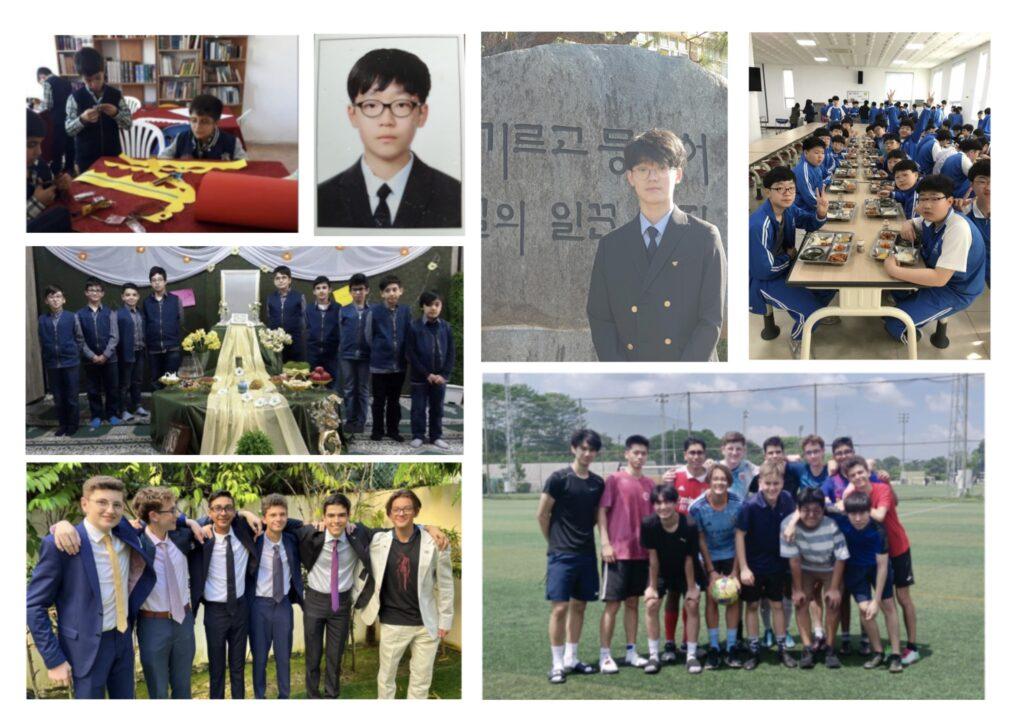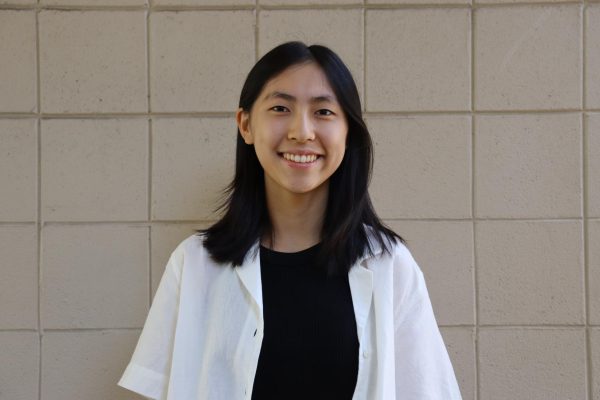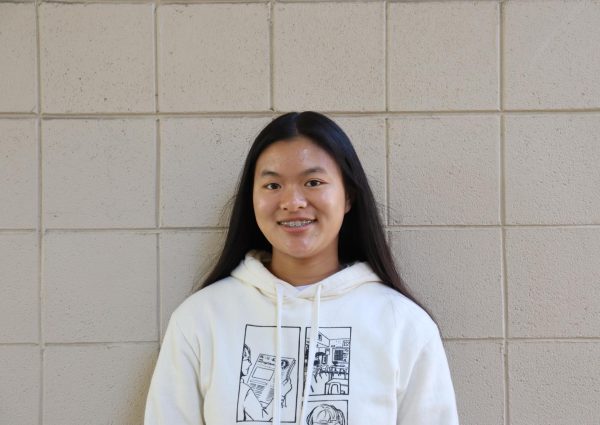When junior June Chang first arrived in Suwanee, Georgia, in March 2022 from his hometown in Busan, South Korea, he was shocked at the scale of everything in the U.S. It seemed to be huge, from the skyscrapers to the local parks. This new environment, along with the less intense pressure to perform well academically, helped shape a vision of his own American Dream: the hopes of being able achieve success and finding what he really wanted in this life without sacrificing seemingly every waking moment of his life for academics — the path he was on in South Korea.
Chang’s father, a college professor, took a year sabbatical from his position and the family chose to stay in Suwanee, a city near his brother, a college student at North Gwinnett College. Inspired by his brother’s advice, Chang later decided to stay in the States, hoping to take advantage of a wider range of educational and future career opportunities.
“I wanted to see and experience a wider world because when I was in Korea most of the students thought that studying hard is the [only] way to success and to live happily,” Chang said. “[Many of those students] didn’t even think about their dreams. But after studying and staying in America, I started to think about my dream and my future.”
Chang is one of dozens of students from around the world who came to live in Saratoga and attend the highly regarded public schools.
The hardships of moving to a new school, especially in a foreign country, often include learning a new language and dealing with complications of transferring credits to the pressures of college applications and leaving well-established friendships back home. Still, most say the move has been worth the difficulties.
Junior June Chang: From Korea to Georgia to California
When Chang arrived in Georgia in March 2022, he looked forward to facing less pressure to achieve perfect grades. However, he was initially hesitant about whether he had made the right choice to stay.
“I knew there were only a few [East or South] Asians in American schools, and I thought that white people were the majority of students. But [that] is not [the case in Georgia],” he said.
As a result of this misconception, Chang wasn’t too keen on moving to the U.S. Initially, as he was worried about how his introverted personality would allow him to make new friends.
His father first brought up the idea of studying abroad in America for a year when Chang’s older brother was attending a pilot college in Florida as part of Korea’s mandatory military service. During his father’s one-year sabbatical, Chang found several considerable changes between the educational system in South Korea and the U.S.
Compared to the more holistic admissions process for undergraduate colleges in the U.S., only a few options ensure a successful career in Korea, all of which hinge on the results of a pressure-packed college entrance exam called Suneung. This exam not only determines a student’s prospective college but also sets the tone for their future career. The relative grading system ensures that only the highest 4% of test takers receive the equivalent of an A, Chang said.
The test, taken every November, is an 8-hour exam that covers math, history, science, Korean language and English. On the test day, public offices and other businesses open an hour late. It’s so serious that during the English listening portion of the test, planes are banned from taking off and landing.
Once attending school here, Chang also observed wide differences in the two systems. Under the standard Korean school structure, every student takes the same class with other students in the same grade, regardless of their individual academic achievement. The same group of students do not move each period; rather, teachers move from room to room, Chang said. Students can’t choose which elective classes they want to take, and there are no AP or Honors equivalents.
After the school day, most students attend study sessions — similar to tutorials — held at school, where they can ask teachers questions or collaborate with peers. Although the sessions at Chang’s school were optional, he said there are other schools that make the sessions compulsory.
For Chang, the most noticeable difference between American and Korean education systems is the way students learn.
“I was surprised that students here don’t feel ashamed when they ask what they don’t know or understand,” Chang said. “In Korea, students make fun of people who ask basic questions. It’s not bullying, but it’s making fun of them as friends — this kind of behavior makes students afraid to ask questions during class.”
After seeing the advantages of the American school system — particularly the lack of a competitive entrance exam — Chang wanted to continue studying in the U.S.
Unable to find a home stay or other means of remaining in Georgia after his father’s sabbatical ended, his parents made an arrangement for him to stay with his mother’s uncle in Saratoga. After both of his parents returned to South Korea early this year, Chang has been living with him since last March.
Among the challenges he is facing this year are writing essays in English and participating in activities like Socratic Seminars. Even so, he is happy to have made the decision to stay here and not face test pressures so prevalent in South Korean schools.
Sophomore Mani Solimani: a long-fought journey to immigration
Sophomore Mani Solimani’s parents wanted to move to America from Iran since he was born, but they were unable to do so until the months leading up to the start of his freshman year, finally overcoming years of visa issues. As a child, Solimani dreamed of one day playing on an NBA team.
His aunt came to the US in 2001 after winning the lottery through the U.S. Diversity Visa Program, and she strongly urged for Solimani’s family to move to America as well.
However, because they did not have enough of the right documents and other issues with the registration, their application was rejected. The Iranian government finally approved it around four years ago, but due to the pandemic, they were unable to move until 2022. After securing their green cards and visas, the family joined their aunt, a longtime resident of Saratoga.
A native Farsi speaker, Solimani had taken English classes both in and out of his Iranian school from 1st to 5th grade, but he soon forgot the language after pausing instruction for three years. In the first few months after moving to SHS in his freshman year, Solimani found it difficult to interpret any of his teachers’ lessons and found tests nearly impossible to complete because of the language barrier.
Solimani had to relearn most of his English through the school’s English Language Development (ELD) class, where they reviewed grammar, read books and held discussions. In addition, Solimani’s aunt helped him with overcoming his language barrier by speaking to him only in English, buying him English books and encouraging him to read for at least an hour daily.
Aside from the language, Solimani has seen differences in cultural norms of tolerance and freedom, which he said interferes with how supportive relationships are formed in communities. In Iran’s authoritarian regime, freedom is restricted and strong censorship is imposed.
During the Iranian Revolution in 1979, Solimani’s uncle was sentenced to a death penalty and executed after speaking out against the government’s tight control on its citizens, including the placement of curfews and the government’s poor handling of the economy.
Because of the restrictions on free speech and the risks that come with violating censorship laws, Solimani said that the social norms of communication limit the extent of some relationships.
Solimani feels that it’s much easier to build relationships here.
“America feels better than Iran because we can support each other. Everyone cares about each other,” he said.
Solimani easily made his best friend, Gabriel Solis Gomez, who moved from Mexico roughly three years ago, in his freshman year P.E. class. They quickly bonded over shared experiences as foreign students.
Solimani said this type of simple friendship wouldn’t have been as easy or trustworthy to form if he faced a similar scenario in Iran. He feels that the Iranian social environment tends to put stubborn, extreme-minded people into a group and pit them against each other, whereas in America, people tend to place more trust in fostering relationships.
“My first thought [upon arrival] was: make friends,” Solimani said. “It was easy because I feel like everyone wants to make friends here.”
Junior Rayyan Ahmad: adjusting to new school systems
Having spent the previous five years living in Singapore, junior Rayyan Ahmad also had adjustments to make when his family moved to Saratoga last August — but not on the level of some other students because of his family’s previous moves. For example, because his education was conducted in English even before arriving in the U.S., Ahmad didn’t face a language barrier in the same way that many foreign students do.
Born in Pakistan, Ahmad moved to Saudi Arabia at age 2. At 12, he moved to Singapore. The family moved as his father changed jobs. Within each of these countries, Ahmad often moved from city to city and frequently changed schools, leading him to become more adaptable to sudden large changes.
His move from Saudi Arabia to Singapore, in particular, was what he called a “massive change,” as he had spent 10 years in Saudi Arabia. However, from Singapore to the U.S., Ahmad didn’t feel the change to be as difficult since he was only in Singapore for a significantly shorter time.
“I feel like I’m less sensitive to change — after the first initial move, I kind of got used to it,” he said.
Ahmad’s father, who previously worked in advertising and marketing for companies like T-Mobile, Nestle and Nivia, began working for Google a year after the family landed in Singapore. Following a series of layoffs and restructuring efforts by Google, Ahmad’s dad took the offer to move to offices in the U.S.
“Some impressions we had were that the U.S. had a lot of opportunity, a lot of freedom, a lot of land, which are all true,” Ahmad said. “One of these freedoms was more accessible education.”
Singapore has 5.5 million people residing in just 283.5 square miles (about five times smaller than Rhode Island, the U.S.’s smallest state). With the high population density, there is also high competition for admission to Singapore’s select few main universities. For example, the country hosts one of Asia’s most acclaimed institutes — the National University of Singapore (NUS), which has an acceptance rate of 5%. For Ahmad and his family, who did not have Singaporean citizenship, it was extremely difficult to get in and receive higher education within the country.
Despite this, Ahmad still had a rigorous class schedule. At a British international school in Singapore, he took a total of nine classes — English, Math, Chemistry, Biology, Physics, Geography, Computer Science, Economics and French — but only had six periods of 55 minutes each a day. This resulted in schedules that varied from day to day, and not every class had the same amount of instructional time in a week. Core classes such as English and Math were fitted into each day of his schedule, along with at least one of his science classes, while electives were taken two to three times a week.
Ahmad said he enjoys Saratoga’s 85-minute classes.
“You can focus more on each class rather than [needing to learn] another concept in another shorter period,” he said. “It helps you better understand the concept and what you’re learning.”
While Ahmad’s Singaporean school had International Baccalaureate (IB) courses, the UK’s equivalent to Advance Placement (AP), there was still a greater focus on standardized testing, such as preparing for the General Certificate of Secondary Education (GCSE). The GCSE consists of exams for each of Ahmad’s subjects, contrasting standardized tests of the American school system such as the SAT and PSAT. Standardized exams are highly valued by employers to compare students against their peers, and they provide student skills information for their secondary school.
While Ahmad said teachers in both countries are generally respectful, kind and always willing to help, he has found that teachers at Saratoga can provide more personalized attention, due to teachers having fewer and smaller classes.
“I feel like the teachers over here have more time for each individual student,” Ahmad said. “[Teachers] can address questions during tutorial. You can go to the teachers and just ask them any questions you have about the class.”
He often spends tutorial in English teacher Mary Palisoul’s classroom, where she offers additional help in working through difficult literature such as the novel “Beloved.” Ahmad said tutorials greatly helped enhance his understanding of the novel and its themes.
Ahmad and his family plan to stay in the U.S. for several more years. He has always had a passion for economics, and he plans to pursue business or finance at a 4-year American university.
“It was kind of difficult to adjust to the new school system [at first],” Ahmad said. “I think I managed to adapt well to the new school system, as everyone here was very supportive. For second semester, I know what each class really wants for me and what it has to offer. And overall, I think [my SHS experience] has been a really positive experience.”




























